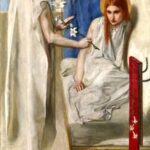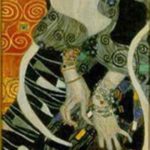When I was maybe ten or twelve years old, an uncle gave me the book The Art Treasures of Europe by Charles Wentinck,1 which was my introduction to a lot of artists, some of whom would become favorites of mine. At the time, Rembrandt was my art hero2 – there are two of his pieces in Wentinck’s book: The Night Watch and Portrait of Jan Six, but as I was familiar with both, I turned my attention to the rest of the tome, which covers prehistory all the way up to the 1960s.
Although I liked many of the paintings illustrated,3 I had very visceral reactions, which I can still feel today, to five of them. These pieces played a large part in the development of my personal aesthetic.
Parmigianino: The Madonna with the Long Neck (1534-40). I know next to nothing about Parmigianino, only what I read in this book and that he also painted the lovely Self-Portrait in a Convex Mirror, but this piece continues to captivate me. I was fascinated by the Mannerist proportions – I loved the Madonna’s neck and hands. I loved her gesture and the whole attitude of her posture. I loved the infant Jesus, who appears to be about six years old. I loved everything about this painting except the small figure in the background at the bottom right of the piece. He bothers me now as he did then. I’m not very knowledgeable about religious iconography, but I’m sure he’s a specific person, probably a saint, with a reason for being there – nonetheless, I find he distracts from the breathtaking delicacy and beauty of the Madonna, child, and attendant angels.
Dante Gabriel Rossetti: Ecce Ancilla Domini: The Annunciation (1850). This is an early painting of Rossetti’s, and although I prefer his later work, it was a fine introduction. I had seen enough Renaissance “Annunciations” to know this was different; I’ve forgotten all the others, but this one has stayed with me. I found the color scheme striking – the painting is predominately white with splashes of the three primaries, which was very unusual for the time. The tight composition and vivid palette are indicative of Rossetti’s sensibility – much more modern, I think, than that of the Impressionists, who worked more-or-less contemporaneously.
Gustav Klimt: Salomé (1909). When I received the book, I had no idea who Salomé was, but I loved the tall thin undulating composition Klimt utilized, which I later learned was related to the “Dance of the Seven Veils” – studies for the painting indicate he arrived at the dynamic pose via sketching a dancing figure. Klimt’s use of ornamentation was also very attractive to me; the integration of the figurative and the decorative in this piece is particularly arresting. In the book, the Klimt segment appears in a chapter titled “Art as Experiment,” and by this time I was ready for the more modern work which would eventually inform my own. Klimt’s evocative imagery did so perhaps as much as anyone’s.
Otto Dix: Portrait of the Journalist Sylvia von Harden (1926). This painting intrigued me to no end. Had it not been for the title, I wouldn’t have known if it were of a man or a woman. Her whole appearance – the mode of dress, the Bryan Ferry hair, the monocle, the positioning of her hands – drew me in. I don’t know that any other portrait, before or since, has made me so curious about its subject. Who was she? What was her life like? Although she sits in a bar or club, she is the only visible figure, alone in a corner with no window. There’s a feeling of liberation in the face of bleakness and desperation, which I would later learn was part of the bohemian culture of Weimar-era Germany, that I found very compelling.
Francis Bacon: Two Figures (1953). What made Two Figures so captivating were its dualities. It looked like a photograph, and yet, with its bravura expressionist brushwork, was obviously not one; the bodies were convincingly fleshy, despite the grisaille palette; the private act seemed to take place in an artificial space, as if it were a performance. I loved the blurriness of the faces and how it was offset by the bold strokes demarcating the bed. I was also fascinated by the “space frame,” which I initially thought delineated the edges of the room; upon closer inspection, I found that to be only partially true, while at points it is superimposed on top of the image.
I don’t know what it was about me that I was so powerfully drawn to these five particular paintings – I do remember I found them all slightly disturbing and strangely alluring, which in retrospect seems like a pretty good combination. I don’t think I analyzed the formal qualities of the work until a little later, but by the time I started painting, I had studied Rossetti, Klimt, and Bacon, and they had become profoundly important to me. All three continue to be among my favorite painters. Had I never been given Wentinck’s book, I’m sure I would have discovered all this work eventually, but seeing it when I did was pivotal in my growth in viewing art, and eventually making it. Thanks, Tom.
1 Simon & Schuster (1974).
2 An aunt had given me the Time-Life Library of Art book of his work. I don’t remember if I was already aware of him, but I loved that book, much more so than the Titian and Van Gogh volumes she also gave me.
3 A list of which includes Velasquez: The Royal Family (c. 1656), Ingres: The Turkish Bath (1863), Degas: The Blue Dancers (1890), Gerhard Richter: Ema, Nude on a Staircase (1966), and Richard Hamilton: Swingeing London 67 (1968).




